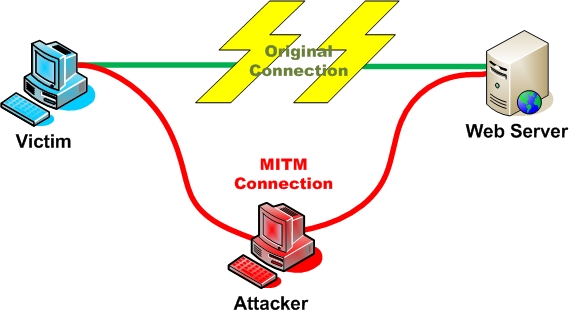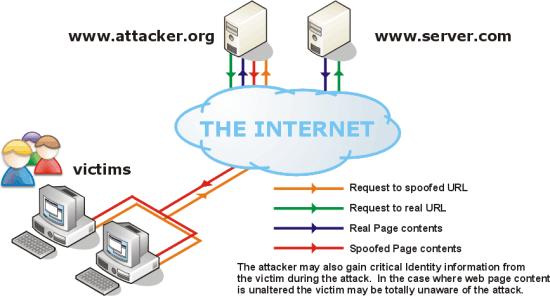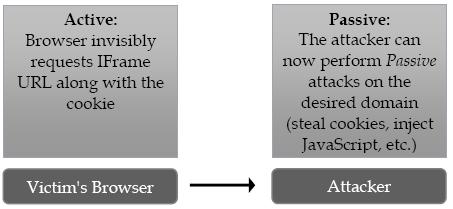Man in the Middle Attack
From Computing and Software Wiki
(→Attack Flow) |
|||
| Line 39: | Line 39: | ||
While active attacks can happen in several ways one of the simplest to imagine is through IFrame injection. The attacker would modify the requested page to include an IFrame with a source of the attacker's choice. | While active attacks can happen in several ways one of the simplest to imagine is through IFrame injection. The attacker would modify the requested page to include an IFrame with a source of the attacker's choice. | ||
===Attack Flow=== | ===Attack Flow=== | ||
| - | + | :1. The victim browses to a page of their choice | |
[[Image:Active_MITM_Flow_1.jpg]] | [[Image:Active_MITM_Flow_1.jpg]] | ||
| - | + | :2. The attacker intercepts the response and injects the IFrame into it | |
[[Image:Active_MITM_Flow_2.jpg]] | [[Image:Active_MITM_Flow_2.jpg]] | ||
| - | + | :3. The user's browser automatically renders the IFrame sending the victim's credentials to the attacker. The attacker now has the victim's credentials and can continue with traditional hacking methods. | |
[[Image:Active_MITM_Flow_3.jpg]] | [[Image:Active_MITM_Flow_3.jpg]] | ||
Revision as of 02:35, 13 April 2009
Man in the Middle Attacks (sometimes MITM) are attacks where the attacker intercepts communication between two parties, forwarding the communication as if the attacker were not present. The name is derived from the popular game Man in the Middle. It is also referred to as a fire-brigade or bucket brigade attack based on the method for putting out a fire. Lastly it is referred to as a Janus attack in reference to the roman two-headed god of gates.[1]
Contents |
Generic Example
Alice sends a communication to Bob, which is intercepted by an attacker, and then forwarded on to Bob. Bob then replies to Alice which is also intercepted by the attacker, and then forwarded to Alice.
Specific MITM Attacks
Historically, several different man in the middle attacks have been described. Perhaps the earliest reference was a paper showing the possibility of IP spoofing in BSD Linux.[2] A more recent and famous example is The Mitnick attack, a man in the middle attack taking advantage of the structure of IP to establish the trusted connections.
Another common man in the middle attack is IP Spoofing, where victims have all their web traffic re-routed through the attacker.[3]
Another common attack is DNS Cache Poisoning, an attack where a user's DNS cache is overwritten, directing their requests through the attacker instead of the correct host.[4]
MITM Attack Examples
LAN
- ARP Poisoining
- DNS Spoofing
- STP Mangling
- Port Stealing
Local to Remote
- ARP Poisoining
- DNS Spoofing
- DHCP Spoofing
- ICMP Redirection
- IRDP Spoofing
- Route Mangling
Remote
- DNS Poisoning
- Traffic
- Route Mangling
Wireless
- Access Point Reassociation
Active MITM Attacks
Recently a new class of MITM attacks have been occurring with two important differences;
- It is initiated by the attacker
- The target is controlled by the attacker rather than limited to the victim's communications
While active attacks can happen in several ways one of the simplest to imagine is through IFrame injection. The attacker would modify the requested page to include an IFrame with a source of the attacker's choice.
Attack Flow
- 1. The victim browses to a page of their choice
- 2. The attacker intercepts the response and injects the IFrame into it
- 3. The user's browser automatically renders the IFrame sending the victim's credentials to the attacker. The attacker now has the victim's credentials and can continue with traditional hacking methods.
Attacking Tools
Defences
The two major issues with MITM attacks are endpoint verification, confirming you are speaking with the desired target and channel security, confirming that the medium of communication has not been infiltrated.
Beyond Computing
See Also
- Bots & Botnets
- Information security awareness
- Network firewall
- Network stack (dode) - attack patterns on each layer & how to defend it
- Operating Systems Security
- Personal Data Protection and Privacy
- Phishing
External Links
References
- [1]
- A Weakness in the 4.2BSD Unix TCP/IP Software, Robert T. Morris, AT&T Bell Laboratories, February 1985
- [2]
- [3]
--Heifetj 10:24, 12 April 2009 (EDT)





